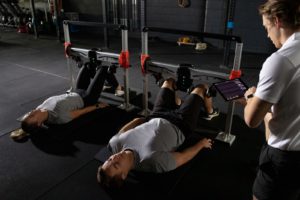RESEARCH SUMMARY: Predicting ankle injury when considered with higher body mass in US special forces (Eagle et al., 2019)
Original research title: Bilateral strength asymmetries and unilateral strength imbalance: predicting ankle injury when considered with higher body mass in US special forces
Authors: Eagle S, Kessels M, Johnson C, Nijst B, Lovalekar M, Krajewski K, Flanagan S, Nindl B, and Connaboy C.
Year: 2019
Purpose
Ankle injuries are very common and costly in Special Forces populations. Previous studies have been unable to consistently identify risk factors that can be used to flag individuals at higher-than-normal risk of sustaining an ankle injury. Early identification of high-risk individuals is crucial for practitioners as they can modify exercise prescription to reduce injury risk.
The purpose of the study was to analyze the anthropometric, physiological, and strength metrics that can be used to predict ankle injury risk over one year.
Methods
Prospective cohort study with 140 U.S. Special forces soldiers. All soldiers were assessed at baseline and followed over time to determine if any metrics could be used to predict ankle injury risk.
Baseline measurements included:
• Age, height, body mass, fat-free mass, aerobic capacity, anaerobic capacity, and body fat percentage.
• Ankle eversion and inversion isometric strength asymmetry.
Key findings
- 14 of the 140 soldiers sustained an ankle injury 1 year after baseline testing.
- Of the measured baseline metrics, strength asymmetry contributed to predicting ankle injury in a multivariate model using body mass.
VALD’s solution
VALD’s ForceFrame isometric strength testing system provides a reliable way to measure strength asymmetries across a range of muscle groups. The system has demonstrated reliability when used to assess ankle strength and can be used in a military population to measure ankle eversion and inversion strength asymmetries. Quantify asymmetries in your population and easily flag high-risk individuals who require specialized physical training with VALD.
See VALD’s Ankle Inversion/Eversion test protocol here.
For the full study, see here.
Would you like to learn more about VALD Tactical Systems?
Contact us at info@valdtactical.com or fill in the contact form here.














